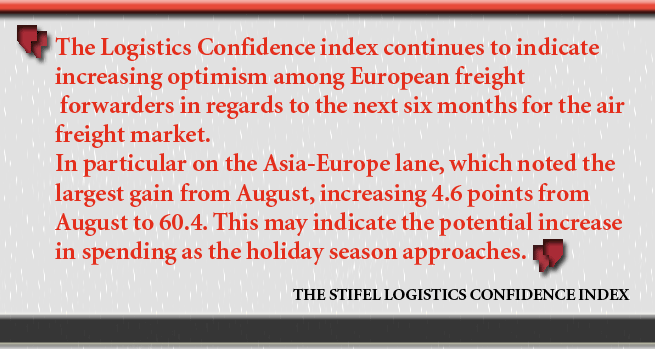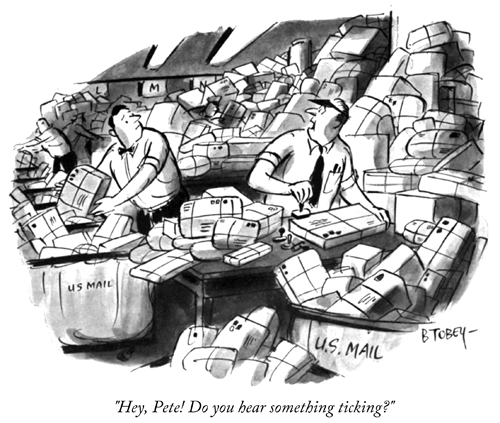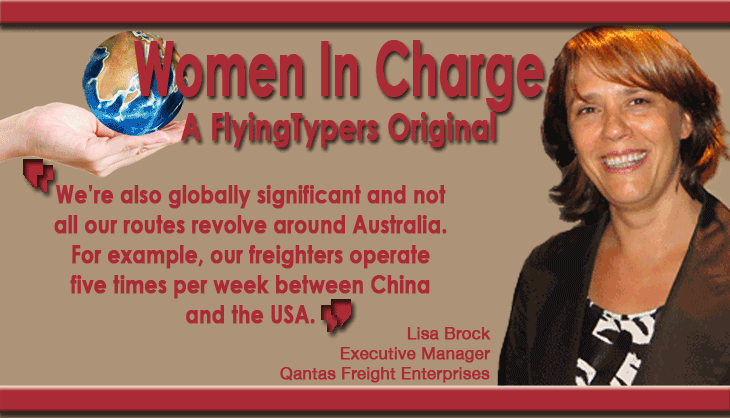
 ould
the major East-West air cargo markets be showing signs of a pick up?
Well . . . yes and no. ould
the major East-West air cargo markets be showing signs of a pick up?
Well . . . yes and no.
Certainly, there are signs that confidence is returning to what has
been a moribund market for a long time.
However, not all the latest volume figures out of Asia support the improved
sentiment, and the picture on rates is rather murky.
 Martin Dixon, (right) Drewry Research
Manager, Freight Rate Benchmarking, is among the bulls.
Martin Dixon, (right) Drewry Research
Manager, Freight Rate Benchmarking, is among the bulls.
He told FlyingTypers
that his company’s East-West Air Freight Price Index, a weighted
average of airfreight rates across 21 East-West trades, gained 2.7 points
in August to climb to 96.9 points. He believes this heralds the start
of a rally that will likely last into the final quarter.
“Pricing hit all-time lows in July
and demand has been improving, so some recovery in rates was anticipated,”
he said. “This despite continued expansion in capacity, driven
by the high season in passenger demand, when airlines expand wide-bodied
cargo space.
“Drewry expects airfreight rates
to continue to rise through September and October, fuelled by new product
launches, tighter capacity conditions, and improving demand for Asian
manufactured goods in North America and Europe.”
The Stifel Logistics Confidence Index,
which measures confidence in freight forwarding markets, also offers
cause for optimism.
 |
The air freight sub-index jumped
1.6 points month-on-month to reach 45.3 in September.
Although improving conditions are only
indicated when the 50 threshold is attained, the September score for
the air freight market was the highest achieved since the Index was
launched in early 2012. Moreover, the Europe-U.S. lane recorded a strong
increase of 4.9 points compared to August, while the U.S.-Europe lane
was up 0.8 points.
“The Logistics Confidence index
continues to indicate increasing optimism among European freight forwarders
in regards to the next six months for the air freight market,”
said a note from Stifel.
“In particular on the Asia-Europe
lane, which noted the largest gain from August, increasing 4.6 points
from August to 60.4. This may indicate the potential increase in spending
as the holiday season approaches.”
A spokesperson for Damco in North Asia
supported the upbeat analysis.
She said the operating environment in
airfreight markets had been difficult in recent months, but the outlook
was turning positive.
“The U.S. and European economy and
consumer confidence has a role to play here,” she said.
“With the recent improvement in
PMI in many key European economies and general improvement in the U.S.
market, it is hoped that volumes will improve in the second half of
this year.”
The boost in confidence is matched by
hard numbers.
At Hong Kong International Airport, the
world’s biggest in terms of international freight movements, cargo
in August rose by 2.7 percent over the same month last year to reach
337,000 tons.
An 8 percent year-on-year increase in
transshipments and rising throughput to and from Mainland China and
South East Asia were the star lanes for HKIA.
Home carrier Cathay Pacific also recorded
a year-on-year rise in August, although of only 0.3 percent in terms
of tonnage, and of 1.4 percent in terms of revenue ton kilometers.
 Stanley
Hui Hon-chung, (left) Chief Executive Officer of Airport Authority Hong
Kong said he was “cautiously optimistic” about cargo performance
in the coming months. Stanley
Hui Hon-chung, (left) Chief Executive Officer of Airport Authority Hong
Kong said he was “cautiously optimistic” about cargo performance
in the coming months.
“Recent economic data suggests a
slow recovery in manufacturing activities in China, as well as trade
with key trading partners,” he explained.
“Shipping freight rates have increased
on some routes, with rising demand expected over the coming seasonal
peak months.”
Yet elsewhere the figures are not so good.
Singapore’s Changi Airport handled 151,000 tons of cargo last
month, a slight decline of 0.5 percent year-on-year, keeping tonnage
stable over a 12-month rolling period.
Figures from the Association of Asia Pacific Airlines were in the black,
but only just. International air cargo demand measured in freight tonne
kilometre terms was just 0.3 percent higher in August compared to the
same month last year, despite a 2.8 percent increase in capacity.
 Mark Sutch, (right) Cathay Pacific General
Manager Cargo Sales & Marketing, said August demand from Europe
and North Asia markets was “particularly soft, though demand on
transpacific flights held up reasonably well thanks in part to the shipment
of perishables.”
Mark Sutch, (right) Cathay Pacific General
Manager Cargo Sales & Marketing, said August demand from Europe
and North Asia markets was “particularly soft, though demand on
transpacific flights held up reasonably well thanks in part to the shipment
of perishables.”
Andrew Herdman, AAPA Director General,
also reported “persistently soft” air freight markets this
year, with a 1.7 percent fall in air freight demand during the first
eight months of the year. He attributed this to lackluster trade growth
and relatively weak markets for electronic products and other high value
goods normally shipped by air.
“There are some signs that the slump
in air cargo experienced over the past couple of years may be bottoming
out, at least in volume terms, but surplus cargo capacity will continue
to exert downward pressure on rates,” he said. “Overall,
Asian airlines are focusing on further growth opportunities, but still
face very challenging business conditions."
Sky King
|






 Stanley
Hui Hon-chung, (left) Chief Executive Officer of Airport Authority Hong
Kong said he was “cautiously optimistic” about cargo performance
in the coming months.
Stanley
Hui Hon-chung, (left) Chief Executive Officer of Airport Authority Hong
Kong said he was “cautiously optimistic” about cargo performance
in the coming months.  Mark Sutch, (right) Cathay Pacific General
Manager Cargo Sales & Marketing, said August demand from Europe
and North Asia markets was “particularly soft, though demand on
transpacific flights held up reasonably well thanks in part to the shipment
of perishables.”
Mark Sutch, (right) Cathay Pacific General
Manager Cargo Sales & Marketing, said August demand from Europe
and North Asia markets was “particularly soft, though demand on
transpacific flights held up reasonably well thanks in part to the shipment
of perishables.”


